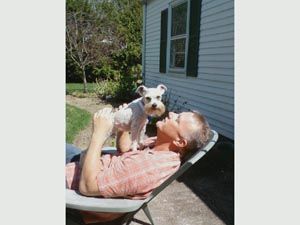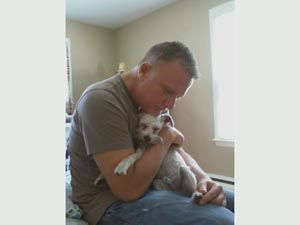Editor’s note: We are delighted to publish an excerpt of Michael Morse‘s newest book, “Mr. Wilson Makes it Home”. Morse, an EMS1 columnist and friend, spent 23 years as a firefighter and EMT in Providence, RI before retiring as a captain in 2013. We consider Morse’s previous books, “Rescuing Providence” and “Responding,” deeply emotional looks into his exhausting 39-hour shifts on the Rescue 5 ambulance, as must reads in the pantheon of EMS literature.
INTRODUCTION
On a brisk April morning, a parking lot full of people waited expectantly for the dogs they had adopted from various animal rescue organizations to arrive. We were together but separate—families, couples, single men and women bonded by the humanity that compelled us to adopt homeless dogs. Anticipation filled the air moments before the red tractor trailer appeared and our dogs arrived.
Then, the magic began. A collective happy-to-be-alive moment, which lasted well over an hour, enveloped us as our dogs were delivered. Afterward, we went our separate ways, each holding onto the precious memories of those moments as well as the parts of our lives that had previously been missing. For the dogs, their four-day trip from “down south” was over. For us, the journey had just begun.
Too often we bask in the negativity that surrounds us and dwell on the things that didn’t happen or should have happened. But unplanned, unexpected, and unbelievable moments do happen. Periodic feelings of bliss can grab us by the throat, shake us to the core, clear our sight, and give us the clarity of mind and presence of body to stop everything, breathe deeply, turn toward the sun, feel its warmth on our skin, and bask in the moment that good fortune has given us. To feel it, acknowledge it, know that it is true, and accept the moment as a gift to be treasured is the most important thing a person can do. Letting something great pass us by without acknowledging the moment is life squandered. I will never forget the moment that Mr. Wilson arrived, for it was perfect.
“Mr. Wilson Makes It Home” is about love, loss, and hope. It has moments of hilarity and heartbreak, training tips for dogs and humans, compassion, giving, taking, eating, laughing, and appreciating the rare moments of grace that make our existence not simply worthwhile, but magnificent.
The gifts we received the day we brought Mr. Wilson home far exceed the simple acquisition of a pet and all the fun that goes with it. My hope for you is that you will see a glimpse of yourselves in our story, and if something is missing in your lives, may it open your heart to the idea of bringing a pet home or, if you already have one, perhaps adopting another.
CHAPTER 1
 When Cheryl decided to get us a dog, nothing could stop her. She made her mind up on a Wednesday; ten days later, on a brisk but beautiful Sunday morning, I held a twelve-pound pooch in my arms. He was a mutt, or at least what used to be considered a mutt, and he melted into my body as though he belonged there, his tired brown eyes barely open and his heart beating away. I thanked the man who handed him off to me and then turned my eyes toward my wife, who leaned on our car, capturing images of random moments with her camera.
When Cheryl decided to get us a dog, nothing could stop her. She made her mind up on a Wednesday; ten days later, on a brisk but beautiful Sunday morning, I held a twelve-pound pooch in my arms. He was a mutt, or at least what used to be considered a mutt, and he melted into my body as though he belonged there, his tired brown eyes barely open and his heart beating away. I thanked the man who handed him off to me and then turned my eyes toward my wife, who leaned on our car, capturing images of random moments with her camera.
She smiled, and I smiled, and Wilson opened those eyes of his completely, and he smiled too. We used to call them mutts, now we call dogs like him “designer dogs.” I think the mutts in my life would get a kick out of that designation; they certainly acted as though they were created by design rather than by misfortune. Mutts were everywhere when I was a kid in the seventies; spaying was not high on a family’s list of priorities. Packs of dogs ran free in the neighborhoods of my town, and nobody really minded. Cardboard signs with the words Free Puppies and an arrow leading to the bounty were a common sight. The signs would be nailed onto wooden phone poles by boys who prowled the neighborhood streets on bicycles equipped with monkey handlebars and banana seats—one hand holding the hammer and signs, the other keeping the bike headed in the right direction, a pocketful of roofing nails poking their skin and no helmets on their heads, but they somehow managed. If your dog had a litter, you would give the pups six weeks to grow, put up the signs, and then give them away.
The mutt that Cheryl found for us is a schnoodle; half poodle and half schnauzer, which is the best of the two breeds combined. Schnoodles are as smart as poodles, strong-willed as schnauzers, clever and active like poodles, and affectionate, like schnauzers. They are great hunting dogs, can retrieve prey, herd, protect, play the piano, and, best of all, they don’t shed.
For a designer dog, Wilson got off to a rough start. His was no life of privilege. There are places where people treat dogs like revenue producers and operate businesses that some call puppy farms, or mills. As their name implies, dogs are treated like cash crops and live in filthy cages. They never run, or play, or feel what it is like to be loved, cherished, and adored by a human. They may spend their days in severe hot or cold temperatures, for it matters not to the people who farm the dogs. They are fed the bare minimum and are diseased and malnourished, but their puppies look good. The public’s insatiable appetite for cute puppies keeps these places going, churning out litter after litter, until the female dogs are unable to deliver, and they are disposed of, or the males lose interest in reproducing, and they disappear.
 The dog that now nestled in my arms and had already captivated me came from such a place. It was hard to believe—he seemed perfect, happy to be alive, and not the product of such a harsh environment. But he was, and now he wasn’t. Somewhere in Arkansas lives, or lived, a poodle and a schnauzer, and their lives have one purpose and one purpose only. Their living conditions are deplorable, and they live in misery, but manage to produce stock for the nation’s pet stores and Internet sites that sell their offspring for a decent profit. Volume is the way to make the most money, so they are forced to pump out as many revenue producers as nature will allow. And so do the other thousands of prisoners that exist in these places. But they make cute puppies ... Somebody bought this one, our new dog, in a pet store and then cast him aside when they realized that owning a dog equals a lot of work.
The dog that now nestled in my arms and had already captivated me came from such a place. It was hard to believe—he seemed perfect, happy to be alive, and not the product of such a harsh environment. But he was, and now he wasn’t. Somewhere in Arkansas lives, or lived, a poodle and a schnauzer, and their lives have one purpose and one purpose only. Their living conditions are deplorable, and they live in misery, but manage to produce stock for the nation’s pet stores and Internet sites that sell their offspring for a decent profit. Volume is the way to make the most money, so they are forced to pump out as many revenue producers as nature will allow. And so do the other thousands of prisoners that exist in these places. But they make cute puppies ... Somebody bought this one, our new dog, in a pet store and then cast him aside when they realized that owning a dog equals a lot of work.
Most of us have learned to be more responsible pet owners, and many people see the value in having our pets spayed and neutered. People are inherently good, and kind, and when presented with the overwhelming data that supports the practice of spaying and neutering, they willingly get on board. By doing so, the supply side of the supply-and-demand equation for free puppies is a little lacking and opportunists abound. I guess the days of the Free Puppy signs on pieces of cardboard are over. Sometimes progress isn’t all that great. But my new dog certainly appeared to be, and I couldn’t believe how good it felt to hold him. Cheryl had taken a leap of faith in getting him, and her gesture was not lost on me. We weren’t simply getting a dog.
We were affirming our bond, our commitment to each other, and our willingness to move forward into an unknown, unpredictable future. His presence in our lives had the potential to create a cohesiveness that had been missing for far too long.
--
Mr. Wilson Makes it Home
Skyhorse Publishing
Copyright © 2015 by Michael Morse
Available on Amazon and wherever books are sold.













